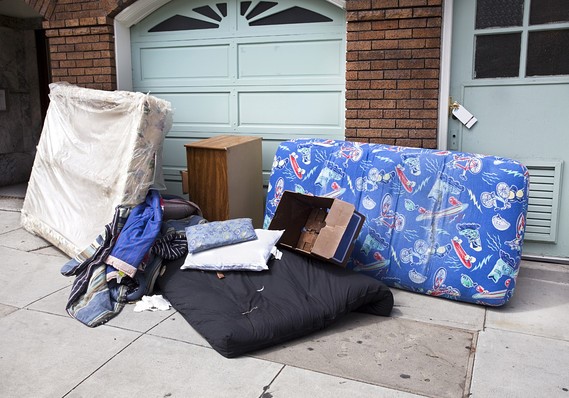The eviction crisis is starting to look a lot like the subprime mortgage crisis! Published: Mar 30, 2019
Georgia State University authors suggest requiring longer rental eviction notice periods and boosting legal representation for tenants

Personal household belongings abandoned on urban sidewalk
Stable housing is increasingly out of reach for many Americans, as both rentals and homes to own grow more expensive and options dwindle. Evictions may be one of the most visible manifestations.
Now, a new study shows that not all evictions are created equal. Scholars at Georgia State University, in conjunction with a ProPublica journalist, examined “serial” eviction filings, or those done repeatedly by a landlord against a tenant. By comparing serial evictions to ordinary ones, the researchers found patterns of landlord behavior and intentions, some of which are reminiscent of the worst of the housing crisis a decade ago.
As a reminder, nearly half of Americans are “rent-burdened,” which means that they spend more than 30% of their income on rent. Homelessness is on the rise. Nationally, as many as one in seven children may have experienced eviction in the last decade. And, just as the foreclosure crisis disproportionately hit African-Americans, so does the eviction epidemic. Black women in Milwaukee, for example, were evicted at a rate three times their share of the population, and black renters in metro Seattle were evicted four times as frequently as whites there, according to earlier research.
The Georgia State authors compiled evidence that eviction proceedings can be predatory: “Filings can be the beginning of a forced removal process, but they are also frequently a tool used to enforce the collection of rent and fees,” they note.
The authors cite several earlier local studies that demonstrate the phenomenon. Researchers in Baltimore, Cleveland and Dallas “found that some landlords viewed the additional revenue from late fees, enforced by the threat of an eviction filing, as a supplemental source of funding in addition to the regular rent roll.”
Work by Matthew Desmond in Milwaukee suggests that “for every eviction executed through the courts, there are two more that effectively occur outside formal judicial processes. Understanding that eviction is on the table as an outcome, families often vacate their units after marking agreements with landlords.”
The Georgia-based authors draw their own conclusions. “Serial filers may cater to tenants who are economically fragile and, like banks charging overdraft fees, they may have identified a way to capitalize on this fragility,” they write.
“The effective premium that tenants pay through late fees is a systematic penalty that the lightly regulated rental market inflicts on those who are economically fragile, not dissimilar from the interest rate penalties that subprime lenders inflict on those with previous credit challenges.”
One-time evictions are more often used to remove problematic tenants, the authors conclude. But, as noted, the fees collected from serial evictions may either provide additional income for landlords, or provide a means of “disciplining the tenant through state-sanctioned threat of removal.”
The use of serial eviction filings as a revenue booster is more likely to be the case among large, professional property managers, rather than mom-and-pop landlords. This is especially important given that property management is trending toward “large corporate ownership,” the authors said.
They see a parallel to another trend in the mortgage market, one that had big repercussions in the housing crisis of a decade ago: “The shift from smaller-scale owner-operators to large, corporate owners using larger property management operations is reminiscent of the transition in mortgage lending from primarily portfolio lending (dominated by savings and loans) up through the 1970s to an originate-to-distribute business model in which lenders sold off loans after originating them.”
It’s worth noting that many observers of the housing market believe the predatory lending practices that encouraged many people to stretch beyond their means to buy homes, and the failure of policymakers to address the pain experienced by so many Americans as a result, led to populist politics, including the shift driving the 2016 presidential campaign.
Indeed, the authors quote an unpublished research paper from Matthew Desmond and others that notes that serial filings can create “psychological strain, social withdrawal and legal cynicism toward the court system.”
Based on their examination of evictions in metro Atlanta, which they concede may not represent the nation as a whole, or other states in particular, the authors also see patterns in how tenants of different races are treated. While serial filers own property in neighborhoods of diverse populations, those who do not file serially tend to be located in areas with lower African-American populations.
What can be done? The authors suggest several policy prescriptions. It’s not enough to make evicting a tenant more expensive, because landlords might simply pass on the higher fees to the tenants. Instead, the authors suggest requiring longer notice periods preceding evictions. Also, requiring or expanding legal representation for tenants could deter serial evictions and also protect tenants. Local governments or housing advocates might also consider making public data on eviction patterns by large landlords.
One of the best policy approaches, however, might simply be to “increase the supply of safe and secure affordable housing to low-income tenants,” the authors write. While that goal remains stubbornly challenging, it doesn’t mean local governments, activists, and market participants shouldn’t keep trying.



